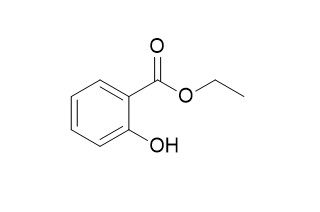Ethyl salicylate
Ethyl salicylate has anti-inflammatory and analgesic activities.
Inquire / Order:
manager@chemfaces.com
Technical Inquiries:
service@chemfaces.com
Tel:
+86-27-84237783
Fax:
+86-27-84254680
Address:
1 Building, No. 83, CheCheng Rd., Wuhan Economic and Technological Development Zone, Wuhan, Hubei 430056, PRC
Providing storage is as stated on the product vial and the vial is kept tightly sealed, the product can be stored for up to
24 months(2-8C).
Wherever possible, you should prepare and use solutions on the same day. However, if you need to make up stock solutions in advance, we recommend that you store the solution as aliquots in tightly sealed vials at -20C. Generally, these will be useable for up to two weeks. Before use, and prior to opening the vial we recommend that you allow your product to equilibrate to room temperature for at least 1 hour.
Need more advice on solubility, usage and handling? Please email to: service@chemfaces.com
The packaging of the product may have turned upside down during transportation, resulting in the natural compounds adhering to the neck or cap of the vial. take the vial out of its packaging and gently shake to let the compounds fall to the bottom of the vial. for liquid products, centrifuge at 200-500 RPM to gather the liquid at the bottom of the vial. try to avoid loss or contamination during handling.
Chemical Engineering Journal2024, 500:157110
Kyung Hee University2024, rs-3888374
J Agric Food Chem.2024, 72(49):27139-27149
Nutr Res Pract2019, 13:e45
Food Hydrocolloids2024, 152:109898
Nat Commun.2024, 15(1):8221.
Russian J. Bioorganic Chemistry2024, 50:2897-2903.
Pharm Biol.2021, 59(1):134-145.
Industrial Crops and Products2020, 146:112186
J Pharm Biomed Anal.2024, 251:116444.
Related and Featured Products
Journal of Pharmaceutical and Biomedical Analysis, 2008,48(3):969-973.
Encapsulation of methyl and ethyl salicylates by β-cyclodextrin: HPLC, UV–vis and molecular modeling studies.[Reference:
WebLink]
The complexation of mEthyl salicylate (MS) and Ethyl salicylate (ES), non-steroidal analgesic, anti-inflammatory and antirrheumatic drugs with β-cyclodextrin (βCD) has been studied from thermodynamic and structural points of view.
METHODS AND RESULTS:
The complexation with βCD has been investigated using reversed-phase liquid chromatography. Retention behavior has been analyzed on a reverse-phase column Luna 18(2) 5 μm. The mobile-phase was methanol:water in different ratios (55:45 to 70:30) in which βCD (1–9 mM) was incorporated as a mobile-phase additive. The decrease in retention times with increasing concentrations of βCD enables the determination of the apparent stability constant of the complexes. Values at 30 °C with 55% methanol were KMS:βCD: 15.84 M−1 and KES:βCD: 12.73 M−1 for MS and ES, respectively. The apparent stability constants decrease as the polarity of the solvent decreases. The low solubility of MS and ES in aqueous solution has been improved by complexation with βCD (1–9 mM). The stability constants of the complexes obtained from the phase-solubility diagrams using a UV–vis spectrophotometric method were ḰMS:βCD: 229 M−1 and ḰES:βCD: 166 M−1. In addition, semi-empirical quantum mechanics calculations using AM1 and PM3 methods in vacuum were performed. The energetically favorable inclusion structures were identified and the most favorable orientation for the inclusion process was found to be the head-down orientation for both complexes.
Enthalpy for encapsulation processes was found to be favorable (ΔH° < 0), while entropy (ΔS° < 0) and Gibbs free energy were unfavorable (ΔG° > 0).
CONCLUSIONS:
By means of HPLC and UV–vis measurements and quantum mechanics calculations, it was found that MS and ES form a 1:1 inclusion complex with βCD. The theoretical results are in agreement with the experimental parameters associated with the encapsulation process.



